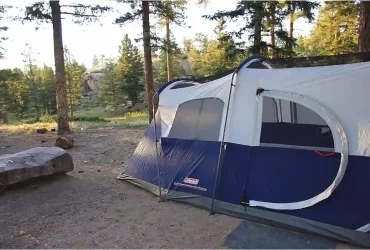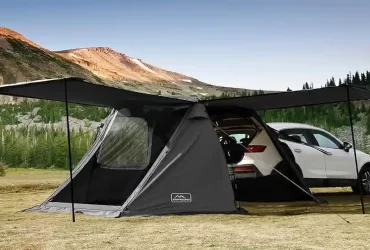Trekking pole tents are ideal lightweight backpacking solutions because of their lightweight design and ability to store all the essential trekking gear. They are often lightweight due to their use of hiking poles instead of tent poles.
There are a number of important factors to consider before purchasing trekking pole tents. Here you will find everything you need to know about trekking pole tents and how to choose the one that is right for you.
Characteristics Of Trekking Pole Tents

It is important to include the best trekking pole tent in your backpacking kit, as they serve numerous purposes. Lightweight tents have many uses and are popular with long-distance hikers for their versatility and convenience. However, they vary greatly depending on your hiking style.
You can choose from a variety of backpacking tents depending on the factors that matter to you and the type of hiking you plan to do. When deciding which backpacking tent to use on your next hike, consider these features.
Light Weight
Whether you are trekking over short or long distances, ultralight tents can reduce your pack weight by up to eight ounces. Individuals use them to reduce their weight while hiking over long distances. The fact that you can store your tent in a smaller space means you won’t need to carry a freestanding tent too.
Also like this:
Space Saving
Choose the best ultralight tents so you don’t have to strap massive tents into your backpack. It is much easier to stuff your tent in a bag with a lot of space if you have one. You’ll save space and be less uncomfortable with a bulky or unbalanced backpack, as well.
Durability
The durability of hiking pole tents is not significantly different from that of freestanding tents. They are also made of materials that are weatherproof and waterproof, such as nylon or silicone-coated polyester.
Protection From Harsh Weather
This tent’s lightweight fabric makes it extremely durable and doesn’t use a shock cord, so it doesn’t wear out as quickly. Trekking pole tents with this design last longer and provide a better experience. It is possible for your trekking poles to break off, but you can easily replace them without having to change your tent.
Designed to withstand harsh weather conditions, trekking tents are made from coated polyethylene or other essential materials that can be used all year round. Therefore, choosing a tent that suits the climate where you will be trekking will ensure you are protected from harsh weather conditions.
Downsides Of Trekking Pole Tents

It is true that trekking tents are fantastic lightweight tents, but their lightweight design does come with some downsides, such as compromises in comfort and utility.
Usability
There is no easy way to pick up and move tents like freestanding tents. Trekking tents must be taken down completely before moving. When you are hiking for a long period of time, it is very exhausting to take down and set up your trekking tent.
Living Space
Although trekking tents are smaller then freestanding tents, the poles allow enough headroom for most people. A disadvantage to trekking tents is that because of the stakes and guylines, there are roof angles on the sides. Double pole tents have more headroom space, which is an advantage of trekking tents.
Not Freestanding
It is important to stake down tent stakes on smooth or level ground, so stakes or poles must be easily driven into that ground. The best ground for staking a tent is soft and level, such as clay or dirt. If you encounter rocks, loose sand, or other conditions that make staking the tent difficult, you may need assistance.
Strength
Tent stakes and tension are specifically used to keep trekking tents in shape due to the lightweight design. Trekking tents are strong and sturdy, but they have some limitations as well.
The freestanding tents depend on all of their components to maintain stability. If any single piece loses its strength, the entire tent collapses. However, if a particular component collapses, the freestanding tent does not collapse at all.
Also like this:
Carbon Fiber Tent Poles Vs. Aluminum Tent Poles
There are a number of pole tent types that are suitable for trekking, but then there are carbon fiber pole tents as well as aluminum pole tents. Other tents, for example, use steel poles in place of carbon fiber poles, which poses certain disadvantages based on the type of trekking, the price, and the location.
Detailed comparisons of the two materials can be found below. Weigh the benefits and drawbacks of each carefully before making a choice.
Carbon Fiber Pole Tents: Highlights
- There is a sense of strength and heft about them.
- Even if a component of the carbon fiber tent poles breaks, the tent will not collapse.
Carbon Fiber Pole Tents Have Drawbacks
- It is expensive to purchase them.
- Because of their soft material, they can wear off quickly over time.
Aluminum Tent Poles: Highlights
- The cost of carbon fiber poles is relatively higher compared to them.
- Their flexibility and light weight make them ideal for camping.
Aluminum tent pole drawbacks
- The tents are light and can easily deform due to their weight.
- It is heavier to use tent poles made of aluminum than carbon fiber poles.
Depending on your preference, trekking pole tents may or may not be necessary for your trekking expedition. In addition, trekking poles are great for backpacking because they are lightweight, so you can figure out what shelter will be most convenient for you, depending on your location and comfort level.
These tents are light and simple, so they are a great alternative to freestanding tents that can be bulky or large. A trekking pole tent offers convenience and efficiency with its multipurpose gear. Though they are popular, trekking pole tents are less durable or easier to erect than freestanding tents.





Leave a Reply
View Comments